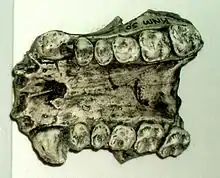Rangwapithecus
Rangwapithecus is an extinct genus of ape from the Early Miocene of Kenya. Late Miocene phalanges from Hungary have also been assigned to this genus, but were later reclassified as Dryopithecus.[1]
| Rangwapithecus | |
|---|---|
 | |
| Jaw of Rangwapithecus gordoni | |
| Scientific classification | |
| Kingdom: | Animalia |
| Phylum: | Chordata |
| Class: | Mammalia |
| Order: | Primates |
| Suborder: | Haplorhini |
| Infraorder: | Simiiformes |
| Family: | †Dendropithecidae |
| Subfamily: | †Nyanzapithecinae |
| Genus: | †Rangwapithecus Andrews, 1974 |
Description
Rangwapithecus weighed approximately 15 kg (33 lb) and the size and shape of the ape's teeth indicate that it was a folivore.[2] An arboreal ape from the earliest Miocene [3] adapted to life in the rainforest, it is associated particularly with Mfangano Island, (Andrews,Kelley 2007)[4] although the species previously inhabited a woodland-bushland environment.[5]
Taxonomy
Sympatric with Proconsul, both classified within Proconsulidae,[6] perhaps synonymous with Proconsul gordoni and Proconsul vancouveringi.[7] Is similar to another species found in Africa.[8]
Rangwapithecus gordoni and P. africanus are similarly sized though they differ morphologically, and both are restricted to Koru and Songhur.[9]
Notes
- Begun 1988
- Fleagle 1999, p. 462
- Lyell 1833, p. 343
- Andrews & Kelley 2007, Abstract
- Andrews & Evans 1979
- Cameron 2004, p. 62
- Tuttle 1986, p. 28
- Leakey & Leakey 1987, Abstract
- Andrews 2000, p. 356
References
- Andrews, Peter (May 2000). "Evolution and Environment in the Hominoidea". In Gee, H (ed.). Shaking the tree: readings from Nature in the history of life. University of Chicago Press. ISBN 978-0-226-28497-2. Retrieved December 2011. Check date values in:
|accessdate=(help)CS1 maint: ref=harv (link) - Andrews, P; Cronin, JE (1982). "The relationships of Sivapithecus and Ramapithecus and the evolution of the orang-utan". Nature. 297 (5867): 541–6. doi:10.1038/297541a0. PMID 7045678.CS1 maint: ref=harv (link)
- Andrews, P.; Evans, E. N. (1979). "The Environment of Ramapithecus in Africa". Paleobiology. 5 (1): 22–30. doi:10.1017/s0094837300006266. JSTOR 2400387.CS1 maint: ref=harv (link)
- Andrews, Peter; Kelley, Jay (2007). "Middle Miocene Dispersals of Apes". Folia Primatologica. 78 (5–6): 328–43. doi:10.1159/000105148. PMID 17855786.CS1 maint: ref=harv (link)
- Begun, David R. (1988). "Catarrhine phalanges from the Late Miocene (Vallesian) of Rudabánya, Hungary" (PDF). Journal of Human Evolution. 17 (4): 413–37. doi:10.1016/0047-2484(88)90030-9. Retrieved December 2012. Check date values in:
|accessdate=(help)CS1 maint: ref=harv (link) - Cameron, D. W. (2004). Hominid adaptations and extinctions. UNSW Press. ISBN 9780868407166. Retrieved December 2011. Check date values in:
|accessdate=(help)CS1 maint: ref=harv (link) - Fleagle, JG (1999). Primate adaptation and evolution. Academic Press. ISBN 978-0-12-260341-9. Retrieved December 2011. Check date values in:
|accessdate=(help)CS1 maint: ref=harv (link) - Greenfield, Leonard Owen (1979). "On the adaptive pattern of "Ramapithecus"". American Journal of Physical Anthropology. 50 (4): 527–48. doi:10.1002/ajpa.1330500406. PMID 111557.CS1 maint: ref=harv (link)
- Greenfield, L. O. (1987). "A Late Divergence Hypothesis". In Ciochon, Russell L.; Fleagle, John G. (eds.). Primate evolution and human origins. Evolutionary Foundations of Human Behavior Series. Transaction Publishers. p. 222. ISBN 9780202011752. Retrieved December 2011. Check date values in:
|accessdate=(help)CS1 maint: ref=harv (link) - Leakey, R.E.; Leakey, M.G. (1987). "A new Miocene small-bodied ape from Kenya". Journal of Human Evolution. 16 (4): 369–87. doi:10.1016/0047-2484(87)90067-4.CS1 maint: ref=harv (link)
- Lyell, C (1833). Principles of geology: being an attempt to explain the former changes of the earth's surface by reference to causes now in operation, Volume 3. J. Murray. Retrieved November 2011. Check date values in:
|accessdate=(help)CS1 maint: ref=harv (link) - Schwartz, JH (1984). "The evolutionary relationships of man and orang-utans". Nature. 308 (5959): 501–5. doi:10.1038/308501a0. PMID 6424028.CS1 maint: ref=harv (link)
- Tuttle, R. (1986). Apes of the world: their social behavior, communication, mentality, and ecology. Noyes Publ. p. 28. ISBN 9780815511045. Retrieved December 2011. Check date values in:
|accessdate=(help)CS1 maint: ref=harv (link) - Tuttle, Russell H. (2006). "Seven Decades of East African Miocene Anthropoid Studies". In Ishida, Hidemi; Tuttle, Russell; Pickford, Martin; Ogihara, Naomichi; Nakatsukasa, Masato (eds.). Human origins and environmental backgrounds. Developments in Primatology: Progress and Prospects. Birkhäuser. pp. 15–29. ISBN 978-0387296388. Retrieved December 2011. Check date values in:
|accessdate=(help)CS1 maint: ref=harv (link)
External links
| Wikimedia Commons has media related to Rangwapithecus. |
- Wolpoff, M. H.; De Bonis, L.; Fleagle, J. G.; Frayer, D. W.; Greenfield, L. O.; Jacobs, K. H.; Protsch, R.; Rightmire, P. G.; Sarich, V. (1982). "Ramapithecus and Hominid Origins [and Comments and Reply]". Current Anthropology. 23 (5): 501–522. doi:10.1086/202893. JSTOR 2742391.